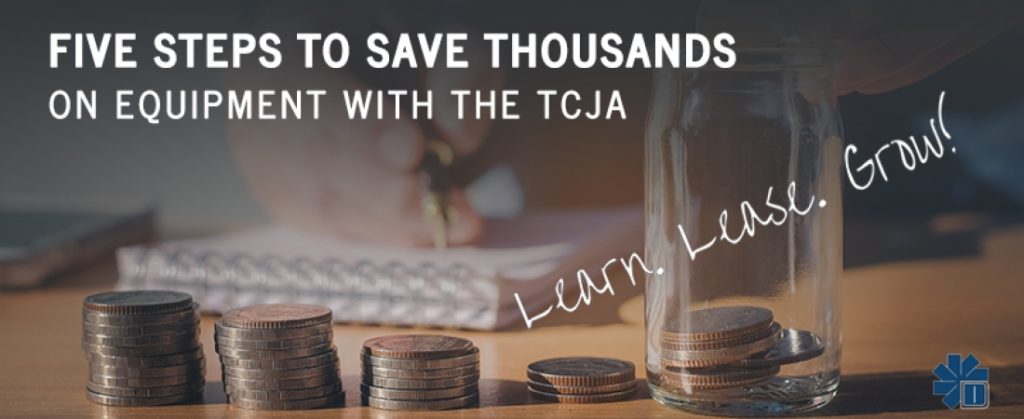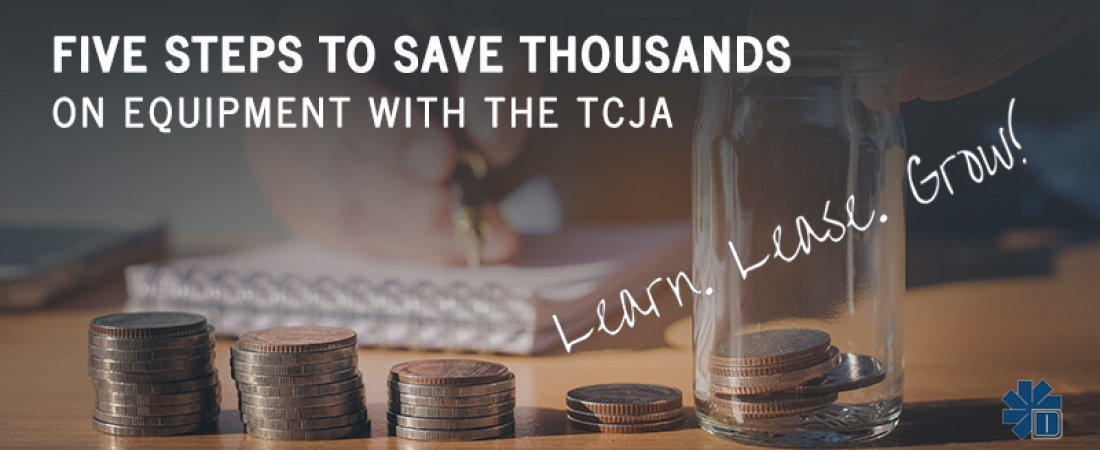FIVE STEPS TO SAVE THOUSANDS ON EQUIPMENT WITH THE TCJA

- February 25, 2019
- 5:33 pm
- Equipment, Section 179, Working Capital
In 2017, President Trump signed into law the Tax Cuts and Jobs Act— a sweeping new tax law with far-reaching effects for businesses of all sizes (source: IRS). While pundits will debate its benefits for the nation, what can’t be denied is that it brings huge value to business owners and their bottom lines. Of the $1.5 trillion in lowered tax liability thanks to the TCJA, $950 billion of that number will go to the business sector (source: Ernst & Young).
One of the most powerful impacts of the TCJA is the way it makes Section 179 tax regulations and bonus depreciation work for businesses. The idea of delving into tax law might not thrill you, but if you’re a business owner who’d like to save thousands or even hundreds of thousands on expenses—it should. It’s not as complex as it seems, and the new changes in the TCJA could transform the way you manage equipment costs and other business costs throughout the year.
Steps to Make TCJA Work for You
Here are some steps you can take to make the TCJA changes work for you:
- Take time to understand Section 179. Section 179 outlines how businesses can write off the expenses of qualifying equipment in their annual tax filings. The problem used to be that businesses could only write off amounts based on the depreciation of their equipment. If you purchased or financed equipment for $100,000, you might only be able to write-off around $10,000 per year in depreciation.
With the introduction of the Tax Cuts and Jobs Act, you can now write off the entire cost of most equipment purchased and used during the year—up to as much as $1,000,000 for 2019. The best part is that this write-off even applies to equipment that you lease or finance. We’ll cover that more later, but for now let’s take a look at the types of equipment that qualify under Section 179. - Learn the types of equipment you can expense. The Tax Cuts and Jobs Act not only increased the total cost you can deduct in equipment expenses, it also expanded the types of business equipment whose costs you can deduct (source: Section179.org). If you purchase or finance and put into use any of the following equipment during the calendar year, it can be claimed on that year’s taxes:
- Equipment purchased for use by your business, including machines and other physical equipment
- Vehicles with a gross vehicle weight (GVW) greater than 6,000 pounds used for your business
- Computers
- Office equipment and office furniture
- Software that has been purchased from a third-party and hasn’t been custom coded for your business
- Qualifying equipment that’s used partly for business and partly for personal use; deduction is based on percentage of business use versus personal use
- Equipment and property that are attached to your business’ physical building, including large manufacturing machinery or other equipment; structural elements of the building don’t qualify
- Non-structural improvements to your existing commercial building, including HVAC or roofing and security systems
As you can see, a large majority of the equipment you might purchase for your business qualifies for the TCJA’s raised deduction limits. So do your research to ensure that you claim deductions on equipment everywhere you can.
- Harness the bonus depreciation increase to 100%. Under the TCJA, bonus depreciation has increased to 100% for 2019. That means that even after you’ve used your Section 179 deduction to lower the purchase price of new equipment, you can take an additional bonus depreciation deduction of 100% of what remains. This 100% bonus depreciation isn’t permanent and will likely be lowered in 2023.
- Finance business equipment to boost your bottom line. With the increased power of Section 179 and bonus depreciation thanks to the Tax Cuts and Jobs Act, choosing to lease or finance equipment in 2019 could be more profitable than you can imagine. Think of it this way—you can deduct the full purchase cost of equipment without paying the full purchase price for that equipment. For example, let’s say you finance $50,000 worth of machinery beginning in November of 2019, with monthly payments of $500. By the end of 2019, you’ll have only spent $1,000 on your equipment, but will be able to deduct tens of thousands of dollars—the full price it will cost to finance that equipment.
- Qualify and save. Besides falling under one of the categories listed in the Types of Equipment You Can Expense section above, there are a few other conditions your equipment will need to qualify for these deductions and savings. The equipment must be bought and put into use in the year its claimed, and the used equipment must also be new to your business. Similarly, you can’t lease or purchase it from an entity with direct connection to your business.
Beyond these conditions, the equipment can be bought, rented, or financed and still qualify for complete Section 179 and TCJA deductions and bonus appreciations.
Financing equipment for your business rather than paying cash has always been a great way to maintain cash flow for your business. But the TCJA act has radically boosted those benefits by letting you deduct the full cost of that financed equipment during the tax year it was put into use.
Recent Posts
- Bonus Depreciation is About to Phase Down to 80% in 2023 December 29, 2022
- Tax Benefits of Buying Equipment & Software Before December 31, 2022 December 8, 2022
- How the Inflation Reduction Act Impacts your Business and You and your Family August 16, 2022
- Recession? What Recession? July 27, 2022
- Dimension Funding Has Paperless Financing April 26, 2022

